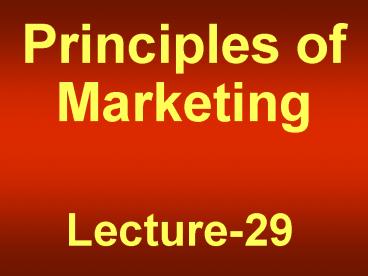Principles of Marketing - PowerPoint PPT Presentation
1 / 64
Title:
Principles of Marketing
Description:
Principles of Marketing Lecture-29 Summary of Lecture-28 Marketing Channels for Consumer Goods Marketing Channels for Business Goods Channel Design Decisions Channel ... – PowerPoint PPT presentation
Number of Views:168
Avg rating:3.0/5.0
Title: Principles of Marketing
1
Principles of Marketing
Lecture-29
2
Summaryof Lecture-28
3
(No Transcript)
4
Manufacturer
Customer
Manufacturer
Customer
Manufacturer
Customer
Manufacturer
Customer
Manufacturer
20 Contacts
5
Manufacturer
Customer
Manufacturer
Customer
Wholesaling Intermediary
Manufacturer
Customer
Manufacturer
Customer
Manufacturer
9 Contacts
6
Marketing Channels for Consumer Goods
7
Producer
Consumer
Producer
Retailer
Consumer
Producer
Wholesaler
Retailer
Consumer
Producer
Agent/ Broker
Wholesaler
Retailer
Consumer
8
Marketing Channels for Business Goods
9
Producer
Business User
Producer
Business User
Agent/ Broker
Producer
Wholesaler
Business User
Producer
Agent/ Broker
Wholesaler
Business User
10
Channel Design Decisions
11
Analyzing Consumer Service Needs
Setting Channel Objectives Constraints
Identifying Major Alternatives
Evaluating the Major Alternatives
Exclusive Distribution
Selective Distribution
Intensive Distribution
12
Channel Management Decisions
13
Selecting
Motivating
FEEDBACK
Evaluating
14
Todays Topics
15
Logistic Management
16
Push Versus Pull Strategy
17
Producer
End users
Interme- diaries
Marketing activities
Demand
Demand
Push Strategy
18
Marketing activities
End users
Interme- diaries
Producer
Demand
Demand
Pull Strategy
19
Producer
End users
Interme- diaries
Marketing activities
Demand
Demand
Push Strategy
Marketing activities
End users
Interme- diaries
Producer
Demand
Demand
Pull Strategy
20
Marketing Logistics and Supply Chain Management
21
- Companies must decide on the best way to store,
handle, and move their products and services from
points of origin to points of consumption.
22
Marketing Logistics (physical distribution)
23
- The tasks involved managing the physical flow of
materials, final goods, and related information
from points of origin to points of consumption to
meet customer requirements at a profit.
24
Supply Chain Management
25
- Managing upstream and downstream value-added
flows of materials, final goods, and related
information among suppliers, the company,
reseller, and final consumers
26
- Marketing Logistics and Supply Chain Management
27
- Involves getting the right product to the right
customers in the right place at the right time. - Marketing logistics addresses
- Outbound distribution,
- Inbound distribution,
- Reverse distribution,
- Entire supply chain management.
28
Supply Chain Management
29
Nature and Importance of Marketing Logistics
30
- Involves getting the right product to the right
customers in the right place at the right time.
31
- Companies today place greater emphasis on
logistics because..
32
- Effective logistics is becoming a key to winning
and keeping customers. - Logistics is a major cost element for most
companies.
33
- The explosion in product variety has created a
need for improved logistics management. - Information technology has created opportunities
for major gains in distribution efficiency.
34
Functions of Logistics Systems
35
Costs Minimize Costs of Attaining
Logistics Objectives
Order Processing Submitted Processed Shipped
Warehousing Storage Distribution
Logistics Functions
Transportation Water, Truck, Rail,
Pipeline Air
Inventory When to order How much to
order Just-in-time
36
Costs
37
Order Processing
38
Order Processing System
System whereby orders are entered into the supply
chain and filled. The order brings the supply
chain in motion.
39
- Order processing involves several stages
- - first, the order is transmitted by a variety
of means such as the Internet, an Extranet, or
EDI - - next, the order is entered into the
appropriate databases - - then the information is sent to those who need
it.
40
Electronic Data Interchange
Information technology that replaces paper
documents that accompany business transactions.
EDI
41
Warehousing
42
- Involves the physical storage or stock-keeping of
raw materials, product components, and/or
finished goods. - Three basic functions
- Movement
- Storage
- Information transfer
43
Warehouse and Materials-Handling
44
Inventory
- When to order?
- How much to order?
- Just-in-Time
45
Inventory Control System
A method of developing and maintaining an
adequate assortment of materials or products to
meet a manufacturers or a customers demand.
46
Just-in-Time (JIT) Concept
47
- JIT is an inventory supply system that operates
with very low inventories and requires fast,
on-time delivery. - When parts are needed for production, they
arrive from supplier just in time, which means
neither before or after they are needed. - JIT is used in situations where demand
forecasting is reliable. It is NOT appropriate
for inventories that are to be stored over a
significant period of time.
48
Transportation
49
Transportation Modes
50
Rail
Truck Flexible in routing time schedules,
efficient for short-hauls of high value goods
Water Low cost for shipping bulky, low-value
goods, slowest form
Pipeline Ship petroleum, natural gas, and
chemicals from sources to markets
Air High cost, ideal when speed is needed or to
ship high-value, low-bulk items
51
Checklist for Choosing Transportation Modes
52
1. Speed.
2. Dependability.
3. Capability.
4. Availability.
5. Cost.
53
Customer Service Concept
54
- Customer service is the ability of logistics
management to satisfy users in terms of - - time
- - dependability
- - communication
- - convenience
55
Right Place
Right Cost
Right Product
Right Time
Right Condition
56
Enough for today. . .
57
Summary
58
Producer
End users
Interme- diaries
Marketing activities
Demand
Demand
Push Strategy
Marketing activities
End users
Interme- diaries
Producer
Demand
Demand
Pull Strategy
59
Marketing Logistics and Supply Chain Management
60
Functions of Logistics Systems
61
Costs Minimize Costs of Attaining
Logistics Objectives
Order Processing Submitted Processed Shipped
Warehousing Storage Distribution
Logistics Functions
Transportation Water, Truck, Rail,
Pipeline Air
Inventory When to order How much to
order Just-in-time
62
Next.
63
Retailing and Wholesaling
64
Principles of Marketing
Lecture-29































